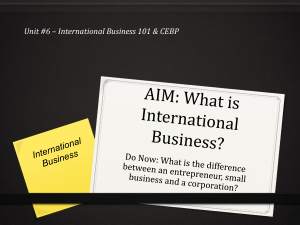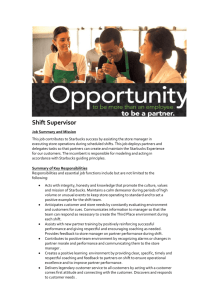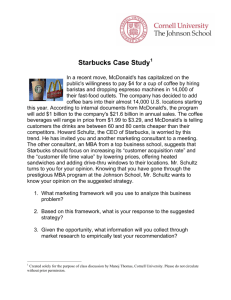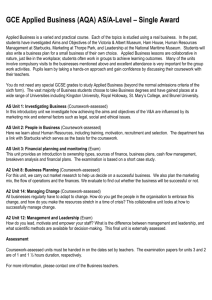Corporate Culture
advertisement
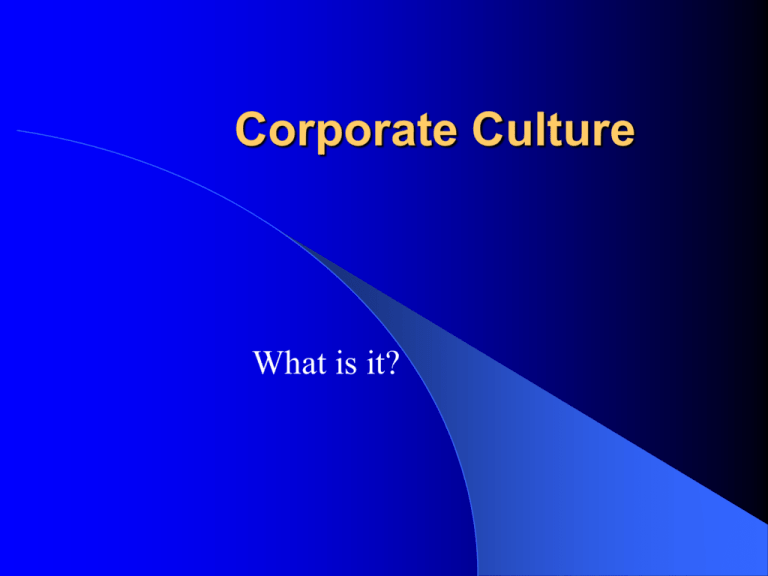
Corporate Culture What is it? Elements of Corp. Culture 1. 2. 3. 4. 5. Business Environment • What is it’s market? Values • Beliefs of the Co. which define success and establish standards Heroes • Embody the culture’s values Rites & Rituals • Systematic routines of day-to-day • Exemplify expected behavior The Cultural Network • How values are communicated through the company. How to understand what’s really going on. Starbucks in Macau Starbucks in Macau Starbucks in Macau Starbucks 1. Business Environment Starbucks purchases and roasts high-quality whole bean coffees and sells them along with fresh, rich-brewed, Italian style espresso beverages, a variety of pastries and confections, and coffee-related accessories and equipment -- primarily through its company-operated retail stores. Starbucks - 2. Values Establish Starbucks as the premier purveyor of the finest coffee in the world while maintaining our uncompromising principles while we grow. The following six guiding principles will help us measure the appropriateness of our decisions: 1. Provide a great work environment and treat each other with respect and dignity. 2. Embrace diversity as an essential component in the way we do business. 3. Apply the highest standards of excellence to the purchasing, roasting and fresh delivery of our coffee. 4. Develop enthusiastically satisfied customers all of the time. 5. Contribute positively to our communities and our environment. 6. Recognize that profitability is essential to our future success. Starbucks - 3. Heroes Howard Schultz Grew up in working-class Brooklyn.His father never made more than $20,000 a year and the family lived in government-subsidized housing, which gave Howard an intense drive to succeed. In his late 20s, working in sales for a company in New York City, Schultz visited a client firm called Starbucks, then a small Seattle purveyor of coffee beans. It was love at first sight. He's a man who lives via revelation, not analysis, and he follows up on each epiphany with unwavering conviction. McDonalds 1. Business Environment It is one of the world’s most well-known and valuable brands and holds a leading share in the globally branded quick service restaurant segment of the informal eatin-out market in virtually every country in which we do business. Serves the world some of its favorite foods – World Famous French Fries, Big Mac, Quarter Pounder, Chicken McNuggets, and Egg McMuffin McDonalds 2. Values We're not just a hamburger company serving people; we're a people company serving hamburgers. For McDonald's to achieve our goal of being the world's best quick service restaurant experience, we must have the best experience for all McDonald's employees. So we formalized our beliefs into our People Vision and our People Promise. Our People Promise is how we remind our people what they can expect and how high our goal is: To be the best employer in each community around the world. McDonalds 2. Values (cond.) People Vision Defines what we strive to be as an employer. Simply put, we aspire to Be the Best Employer in Each Community Around the World. People Promise To the 1.5 million people who work at McDonald's in 119 countries around the world, and to all future employees, we want you to know that: We Value You, Your Growth and Your Contributions. “Our culture supports our vision” 1. We Care – We want to have lifelong relationships with our customers. We seek to understand, meet their needs, care about our employees, and are concerned about our environment 2. We Innovate – We create, build and market innovative solutions; constantly looking for new and innovative ways to work and new ways to spark new innovation 3. We uphold – Quality: we produce reliable products, but quality for us also encompasses the quality of the experience of using the product as part of a total solution that delivers lifestyle benefits. 4. We Celebrate – Enjoyment: We aim to bring enjoyment and pleasure to our customers as we celebrate the beauty we see in life. Corporate Culture System of Rewards Hiring Decisions Management Structures Risk Taking Physical Setting National Cultural Influences Asians place a high value on concepts associated with social harmony, while Westerners put greater emphasis on individuals’ rights and responsibilities. There is no escaping the fact that a national culture HELPS shape corporate responsibilities, practices, and traditions. Cause and Effect …the type of organizational structure that has emerged across Asia is one of a very hierarchical, bureaucratic corporation that values such intangibles as “respect for learning” and “honesty.” Profitable Corp. Culture Does it have any measurable impact on a corporation’s bottom line or staff behavior? Strong Corporate Culture Clear sense of identity for staff Clarifies behavior Clarifies expectations Makes decision making fairly easy because so much is already defined Weak Corporate Culture Employees will “vote with their feet” Decisions are hard to make and wrong decisions are easily made Views of Success The main goal of any corporation is to be successful. How you define success will have an impact on how you organize your business and its culture. Cultural Differences China and America – Is salary talked about? – How do vertical relationships affect promotion? Societal and Institutional Differences Aspects Ethnic Culture China US Centered around "relationships" Centered around "individuals" "Reclusive", each minding his/her own business (especially with "strangers" and people outside of the relationship network) "Messianic": "let's save the world" Source of Trust Trust those around you; don't "lose face" and credibility by failing to live up to written or oral agreements Trust the contract; don't get into legal hassles by not fulfilling the agreement Business Culture Quiet and reserved; clumsy communicators Outspoken; eloquent; effective communicators Societal and Institutional Differences Aspects China US Negotiation Style Group decision; final say by the "boss" More individual authority and distributed decision making Dealing with Business Counterparts Indirect; courteous; take things personally; long memory for both favors and humiliations Direct; more matter-offactly; memory for conflict superceded by business objective Ability to Make Immediate Response Weak Strong Value Differences Aspects China US Interpersonal "Relationship" comes first "Economics" comes first What Commands Respect Respect for seniority, wisdom, ability Respect for success, achievement, wealth On "Family" Children should learn to respect the elder, love the young, and rely on the "extended family" Children should learn to be independent On "the Strong" and "the Weak" It is not righteous to bully It is an honor to win; business is all a competition; it is only natural that the weak is preyed on by the strong Value Differences Aspects China US Discipline (in following procedures and schedules) Strong Depends on the individual Tolerance of Diversity / Openness to Alternative (possibly opposing) Ideas Openly - very receptive; but actually, less so More open Shame or Humiliation Long memory; need and urge to exonerate Tends to be superceded by business priorities Priorities Mixed: business, individual, factional, nationalistic, and political Almost strictly business Geert Hofstede’s Research A corporate/organizational level of culture is achieved according to the way employees have been socialized by their work organization. Power Distance Individualism Masculinity Uncertainty Avoidance Long Term Orientation Power Distance predicted upon: – geographical latitude – population size – nation’s wealth Low Power Distance High Power Distance The use of power should be legitimate and is subject to criteria of good and evil Might prevails over right, whoever holds the power is right and good. All should have equal rights The powerful have privileges Power is based on forma l position, expertise and abilit y to give rewards Power is based on family or friends, charisma , and abilit y to use force. Individualism vs. Collectivism Collectivist items: Training Physical conditions Use of skills Individualist items: – Personal time – Freedom – Challenge Collec tivism Individualis m Colle ctive interests prevail over individual interests Individual interests prevail over collective interests Private life is invaded by groups Everyone has a right to privacy Opinions are predetermined by group memb ership Everyone is expected to have a private opinion Hiring and promo tion decisions take emp loyees’ in-groups into account Hiring and promo tion decisions are supposed to be based on skill s and rules only. High PDI Low PDI Masculinity vs. Feminity Statistics showed relationship between masculinity and age. Young men and women tend to be more masculine, wheras the older men and women tend to be more feminine. Femini ne Masculine The needy should be helped The strong should be supported Everybody is suppose to be mod est Men are suppose to be assertive, ambit ious and tough Live in order to work Work in order to live Manager, Cooperation, living area, employment security Earnings, recognition, advancement, challenge Uncertainty Avoidance Relationship between the strength of uncertainty avoidance in a country and the maximum speeds allowed in freeway traffic in that country. Avoid uncertainty less Avoid uncertainty more Low stress; subjective feeling of wellbeing Comfortable in ambiguous situations and with unfamiliar risks Citizen protest acceptable High stress; subjective feeling of anxiety Citizens positive towards institutions Citizens negative towards political process Conservatism, extremism, law and order Tolerance and moderation Acceptance of fami liar risks, fear of ambiguous and unfamili ar risk Citizen protest should be repressed Long Term Orientation Long term: – Persistence/perseverance – Ordering relationships by status and observing this order – Thrift – Sense of shame – Respect for traditions Short term: – Personal steadiness and stability – Protecting your face – Respect for tradition – Reciprocation of greetings – Favors & gifts – Adaptation of traditions to a modern context

